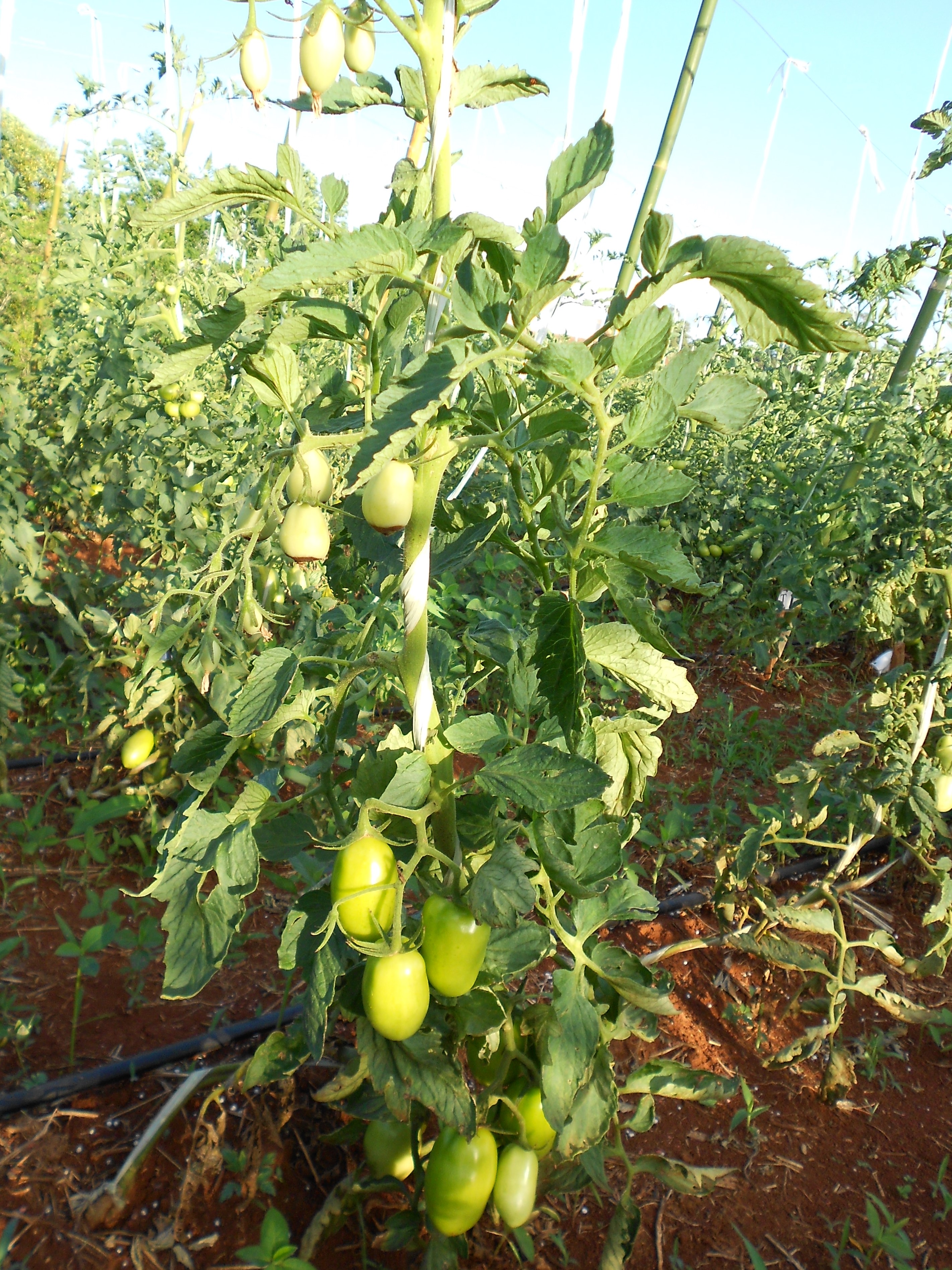Relationship between morpho-agronomic traits in tomato hybrids

Abstract
The objective of this study was to identify and estimate the relationships between production component variables and fruit yields in tomatoes. This experiment was conducted in a randomized block design with a 2×3×3 factorial arrangement, with two tomato hybrids (Netuno and San Vito), three doses of boron (H3BO3 - 0, 2, 4 g pit1) and three calcium floral applications (no application; application every 7 days; and application every 14 days), totaling 18 treatments with four replications and 20 plants per plot. Pearson correlation coefficients were estimated between the measured variables and, after that, those with greater significance were selected for productivity with the Stepwise method and verification of multicollinearity using the number of condition and inflation factor of the variance. The correlations of the selected variables were decomposed into direct and indirect effects on fruit productivity with path analysis. There was a strong correlation between the variables, excluding the variables height, diameter and average mass of the fruits. Thus, there were cause and effect relationships between the independent variable total mass of the fruits and the principal variable total fruit yield. The variables diameter and total number of fruits did not contribute to an increased tomato production.
Keywords
Solanum lycopersicum, Path analysis, Pearson's correlation, Multicollinearity, Stepwise, Plant nutrition
References
- Alvares, C.A., J.L. Stape, P.C. Sentelhas, J.L.G Moraes, G. Sparovek. 2013. Koppen’s climate classification map for Brazil. Meteorol. Zeitschrift 22, 711–728. doi:10.1127/0941-2948/2013/0507
- Anuário brasileiro de hortaliças, 2017. Hortaliças, Cleonice de Carvalho Benno Bernardo Kis. Editora Gazeta, Santa Cruz do Sul.
- Bastías, E., C. Alcaraz-López , I. Bonilla, M.C. Martínez-Ballesta , L. Bolaños, M. Carvajal. 2010. Interactions between salinity and boron toxicity in tomato plants involve apoplastic calcium. J. Plant Physiol. 167, 54–60. doi:10.1016/J.JPLPH.2009.07.014
- Cruz, C.D., A.J. Regazzi, P.C.S. Carneiro. 2012. Modelos biométricos aplicados ao melhoramento genético, 4th ed. Editora UFV, Viçosa.
- Donazzolo, J., V.P. Salla, S.A.Z. Sasso , M.A. Danner, I. Citadin, R.O. Nodari. 2017. Path analysis for selection of feijoa with greater pulp weight. Ciência Rural 47. doi:10.1590/0103-8478cr20161062
- Edel, K.H., E. Marchadier, C. Brownlee, J. Kudla, A.M Hetherington. 2017. The Evolution of Calcium-Based Signalling in Plants. Curr. Biol. 27, R667–R679. doi:10.1016/J.CUB.2017.05.020
- Fallahi, H.-R., S.H.R. Ramazani, M. Ghorbany, M. Aghhavani-Shajari. 2017. Path and factor analysis of roselle (Hibiscus sabdariffa L.) performance. J. Appl. Res. Med. Aromat. Plants 6, 119–125. doi:10.1016/J.JARMAP.2017.04.001
- FAO, 2017. FAO: Food and Agriculture Organization of the United Nations Statistics Division. [WWW Document]. URL http://www.fao.org/faostat/en/#data/QC
- González-Fontes, A., M.T. Navarro-Gochicoa, C.J. Ceacero, M.B. Herrera-Rodríguez, J.J. Camacho-Cristóbal, J. Rexach. 2017. Understanding calcium transport and signaling, and its use efficiency in vascular plants, in: Plant Macronutrient Use Efficiency. Elsevier, pp. 165–180. doi:10.1016/B978-0-12-811308-0.00009-0
- Kumar, D., R. Kumar, S. Kumar, M.L. Bhardwaj, M.C.Thakur, R. Kumar, K.S. Thakur, B.S. Dogra, A.Vikram, A. Thakur, P. Kumar. 2013. Genetic Variability, Correlation and Path Coefficient Analysis in Tomato. Int. J. Veg. Sci. 19, 313–323. doi:10.1080/19315260.2012.726701
- Lúcio, A.D., Storck, L., Krause, W., Gonçalves, R.Q., Nied, A.H., 2013. Relações entre os caracteres de maracujazeiro-azedo. Ciência Rural 43, 225–232. doi:10.1590/S0103-84782013000200006
- Moreira, S.O., L.S.A.Gonçalves, R. Rodrigues, C.P. Sudré, A.T. Amaral Júnior, A.M. Medeiros. 2013. Correlações e análise de trilha sob multicolinearidade em linhas recombinadas de pimenta (Capsicum annuum L.). Rev. Bras. Ciencias Agrar. 8, 15–20. doi:10.5039/agraria.v8i1a1726
- Olivoto, T., V.Q. de Souza, M. Nardino, I.R. Carvalho, M. Ferrari, A.J. Pelegrin, V.J. Szareski, D. Schmidt. 2017. Multicollinearity in path analysis: A simple method to reduce its effects. Agron. J. 109, 131–142. doi:10.2134/agronj2016.04.0196
- R Core Team, 2017. R: A language and environment for statistical computing. R Foundation for Statistical Computing.
- Rafiei, F., G.H.A. Saeidi. 2005. GENOTYPIC AND Phenotypic relationships among agronomic traits and yield components in safflower (Carthamus tinctorious l.). Sci. J. Agric. 28, 137–148.
- Rios, S. de A., A. Borém, P.E.O. Guimarães, M.C.D. Paes. 2012. Análise de trilha para carotenoides em milho. Rev. Ceres 59, 368–373. doi:10.1590/S0034-737X2012000300011
- Rodrigues, G.B., B.G. Marim, D.J.H. Silva, A.P. Mattedi, V. S. Almeida. 2010. Análise de trilha de componentes de produção primários e secundários em tomateiro do grupo Salada. Pesqui. Agropecuária Bras. 45, 155–162. doi:10.1590/S0100-204X2010000200006
- Sari, B.G., A.D. Lúcio, C.S. Santana, S.J. Lopes. 2017. Linear relationships between cherry tomato traits. Ciência Rural 47. doi:10.1590/0103-8478cr20160666
- Taiz, L., E. Zeiger, I. Moller, A. Murphy. 2017. Fisiologia e desenvolvimento vegetal, 6th ed. Artmed, Porto Alegre.
- Toebe, M., A.C. Filho. 2013. Multivariate nonnormality and multicollinearity in path analysis in corn. Pesqui. Agropecu. Bras. 48, 466–477. doi:10.1590/S0100-204X2013000500002
- Wright, S., 1923. The theory of path coefficients a reply to nile’s criticism. Genetics 8, 239–255.
